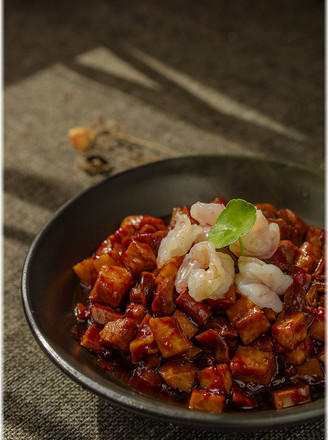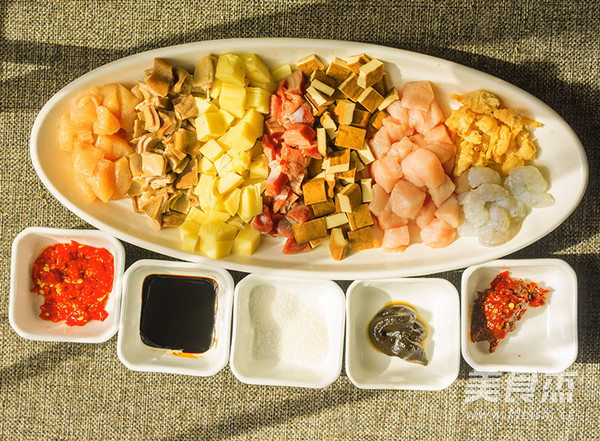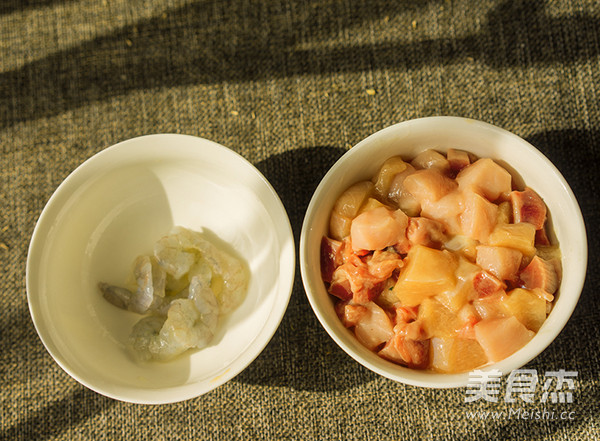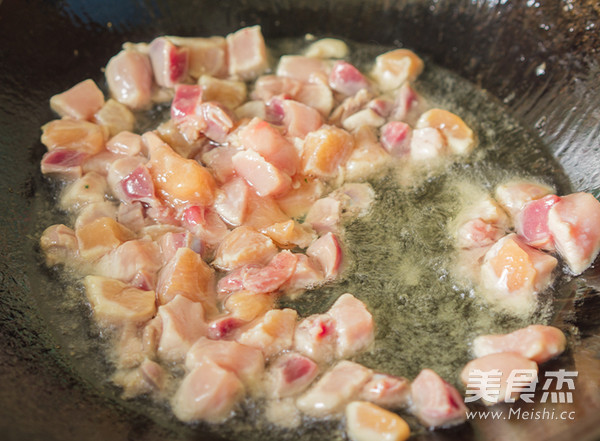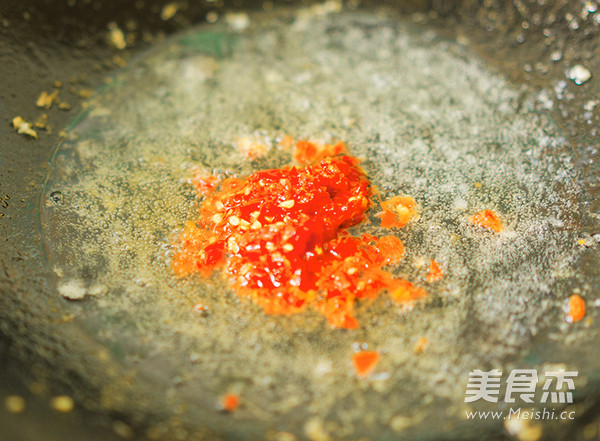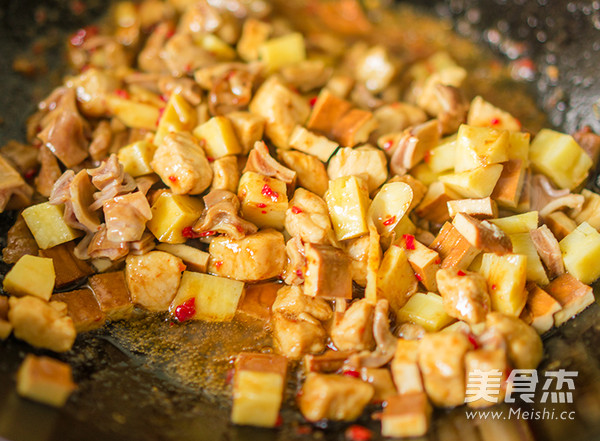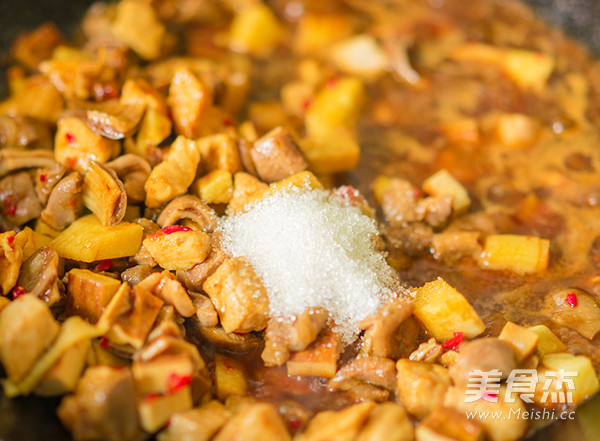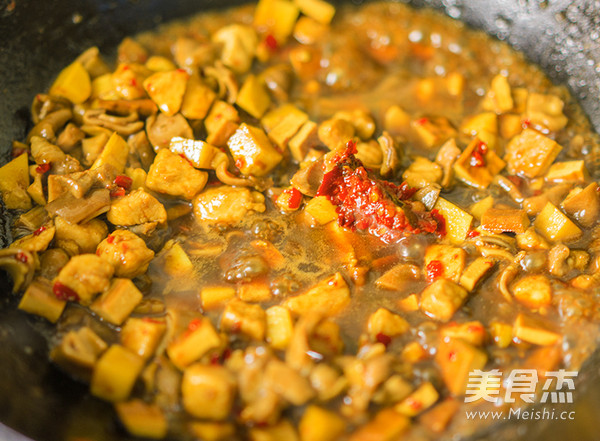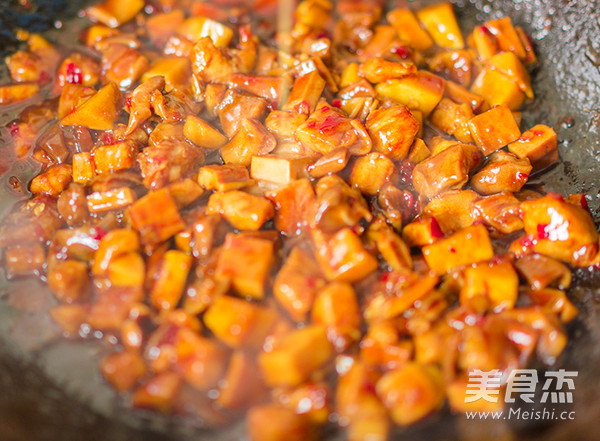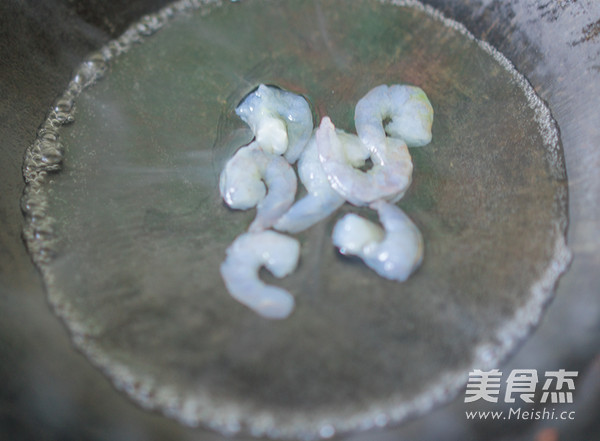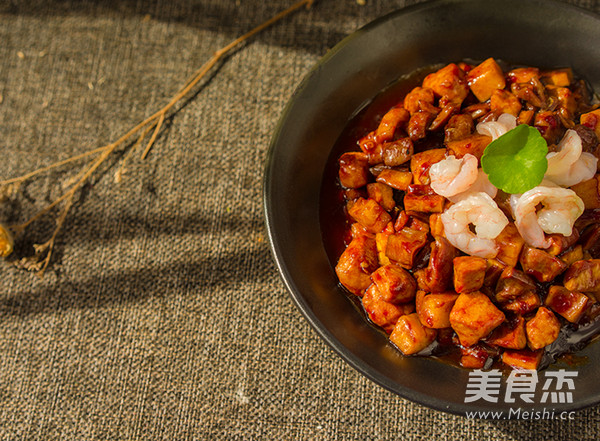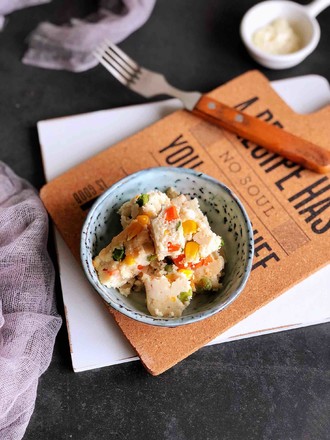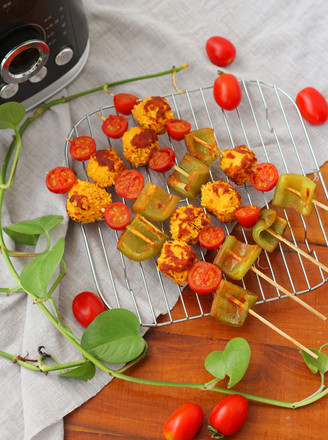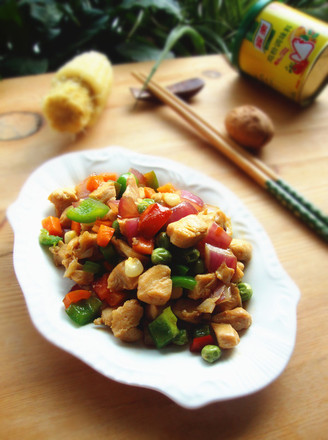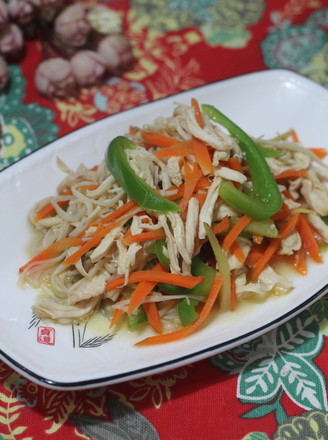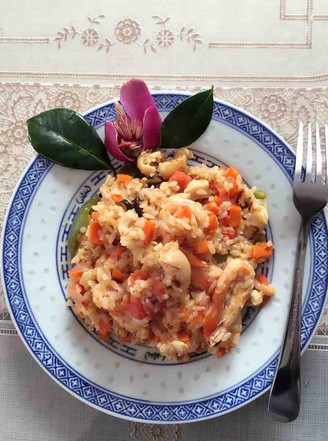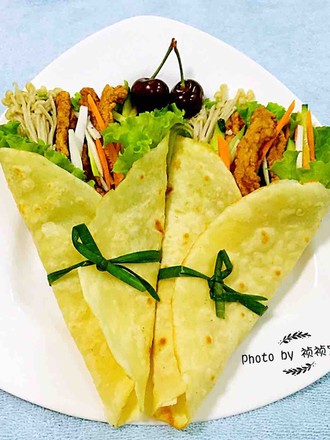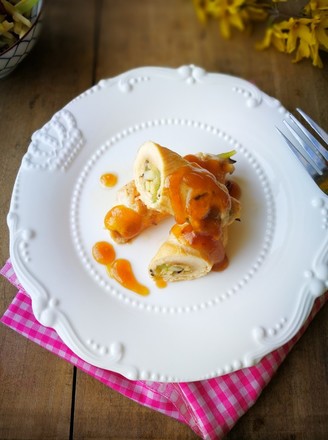The Accent of Babao Chili Sauce
by Cheongsam by the stove
Favorite
Difficulty
Easy
Time
10m
Serving
3
The "Tone" of Babao Chili Sauce
People who go to our restaurant for the first time often look at the "four fresh yellow sauce" and "eight treasure hot sauce" on the menu in a daze. They often firmly think: Is the sauce not a condiment? Why do people in Shanghai sell condiments as vegetables?
This is a long story.
Nowadays, people go to restaurants, although they are called "dining", but in fact, people often rush to taste delicious food. As for whether or not to eat a bowl of rice during the banquet, it is quite unimportant. However, in the early stages of the development of local cuisine, how to better "serve food" is the first question that Shanghai chefs need to consider.
In the eyes of the middle- and lower-class Shanghai citizens in the late Qing Dynasty and the early Republic of China, if a dish cannot make people appetite, then this dish is somewhat "foreign". And among the most original local dishes such as smashed pork, shredded pork skin, pork soy soup, fried pork Baiye (baiyejie roast pork), fried fish tofu (braised fish cubes and old tofu), etc. , And the "sauce" dishes that combine meals and can be eaten in rice are more popular. This is why Shanghainese nowadays often refer to such delicious and affordable dishes as "dishes for dinner."
The so-called "pickles" in Shanghai is not the pickles eaten with porridge such as pickled radish heads and stinky fermented bean curd in the eyes of outsiders, but a kind of pickles that look like a pile of mush and resemble "sauce" in appearance. "The dishes.
Eight treasures chili sauce is one of the masterpieces. It can be said that if you understand the famous ingredients in Babao Hot Sauce, you will almost understand half of the "thick oil red sauce" of this gang dish.
The authentic local eight-treasure hot sauce is actually a kind of mixed stir-fry. This is one of the few "anti-customer-oriented" classic dishes among the local dishes.
The reason for this expression is that although there are indeed eight main ingredients with different tastes in this dish of elegance and desire, the "eight treasures" are actually not the protagonist of this dish, the real protagonist. It's the so-called "hot sauce".
This is a kind of compound flavor that is sweet, salty, spicy and fresh. This very Shanghai-style sauce blends the two extremely contradictory "fresh appetizers" and "lasting mouth". Sense of taste. And when this kind of light and heavy, soft and firm, elegant and strong, lively and old and heavy at the same time impact your taste buds, you will understand what is the penetrating power of taste!
This flavor was obviously not as elegant as it is today. At first, its name was "Hot Sauce". As for it originated in Baoshan or Sanlintang and Chuansha? There is no more to test now, but it is certain that it must have originated from the hands of these Shanghai countryside chefs, because during the Guangxu period, almost all the local restaurants had such a dish. The difference is that after entering the city , The main ingredient of this dish is said to be "eight treasures", but the small bosses have some similarities and differences.
The Babao Chili Sauce was made a little famous for the appetizer, and it was Jin Amao from a family in spring. This is not to say that the Rongshun restaurant that he opened two years earlier and Renhe restaurant that opened earlier are definitely not as good as his eight-treasure hot sauce. Perhaps the house-keeping dishes such as bacon Baiping in Rongshun restaurant and braised yellow croaker in Renhe restaurant are. Their fame has overwhelmed their Babao Chili Sauce. One Spring’s main dish is all kinds of "side dishes", and Babao Chili Sauce is just one of Jin Amao’s signature dishes.
Babao hot sauce is not as simple as mixing the condiments in proportion and putting them in the pot. This is a skillful dish, especially for fire work and seasoning. People who don't have a bit of savvy can hardly make this dish a charm all at once.
There is no fixed number for the main ingredients of Babao spicy sauce. Generally speaking, there are eight kinds of gizzard slices, diced chicken, diced meat, belly diced, dried shrimps (kaiyang), diced bamboo shoots, peanuts, dried tofu, etc. (you can also add other diced grains) raw material). The crispy ones are gizzards, diced bamboo shoots, and peanuts, the soft ones are dried shrimps, tripe, and dried tofu, and the tender ones are diced chicken and diced meat. With a spoonful of entrance, all kinds of different tastes complement each other, and the teeth and tongue are busy.
But it is not important, what is important is how to deal with that mysterious hot sauce. Although in previous descriptions, we have no way of knowing how the Jin Amao, who was in the spring of his family, was playing around the pot and tampering with his little secrets, but fortunately more than a hundred years later, the cooking skills of this gang have gone through a number of times. In the eyes of Master Ren Defeng of the Shanghai Old Restaurant (formerly Rongshun Hall), these skills are already well-acquainted with the repeated scrutiny of the acting chef.
Ren Defeng said: The difficulty with Babao Chili Sauce is that it must pay attention to both fire and seasoning. The proportion of condiments is inaccurate, and the rest is nothing. However, what is more important than the seasoning ratio is how to handle the heat. If the heat is not properly handled, the taste of Babao spicy sauce will not have that unique charm.
When the bottom oil in the pot is 50% hot, add the spicy sauce (this kind of spicy sauce is called "spicy paste sauce" by the Shanghainese, which is a kind of low-spicy soil sauce marinated with the local fresh spicy sauce). If the hot sauce is too high, the hot sauce will be bitter, and if the oil temperature is too low, the red oil will not come out. Nowadays, the masters who do not know how to use Sichuan bean paste are all used for stir-frying. They do not realize that Sichuan bean paste is a kind of fermented hot sauce. The taste is too dull and can not produce the freshness and jumping of the taste of the spicy paste sauce. Sense, this is a half move.
After the red oil comes out, add the ingredients for the eight treasures and stir-fry until it is thoroughly fried. What is stir-fried, that is, the gizzard slices and belly diced are rolled up. At this step, Shao wine, soy sauce, sugar, a little Sichuan bean paste, and a little meat broth will look like a half-soup dish in the pot. Up. At this time, a lid must be added, and after the high fire is boiled, move to a small fire.
In the eyes of our chef, the two concepts of stir-frying and roasting are not very clear. This is because the local dishes look like fried dishes, and one step of cooking is often indispensable. Stir-fried eel paste, fried crab roe, fried bald lung, and fried chili sauce actually all have a burning process. This is because the fire is often too strong and difficult to taste, and the fire is not enough to tighten the soup, so it must Combination of stir-fry, civil and military complement each other, only in this way can there be a Jiangnan charm of the needle in the cotton.
This step is the key to the key. The seasoning must be in place in one step, the soup must be no more or less, and the fire must be soft and firm. The chef cannot open the lid at this moment, but can only rely on his senses to understand whether the sauce can compound the flavor under effective firepower conditions. This process is not long, only three to five minutes. When you judge that the sweet, salty, spicy, and freshness in the sauce is almost a little bit more complex, it will be in place. If after this point, the taste is completely compounded, then it is hardened, and the expert will say: the taste is dead; and it is a breath away, these condiments have not yet united into a family.
The feeling of this breath is to ensure that the taste has both "unity" and "separation", both "identity" and "harmony". This kind of contradictory unity of taste is the essence of the local hot sauce. These three to five minutes are enough to reflect the chef's understanding of taste.
Next, collect the juice over a high fire, while shaking the pot, pour it down with wet starch to thicken it. This is the basic skill of a chef, and it is generally not wrong. After the marinade is wrapped tightly with the eight treasures, the oil is poured out of the pan. After serving, you must "bright sauce, first-line oil", and add the "hat" of the fried shrimp. These sweeping gestures should be clean and beautiful. Dao Babao Chili Sauce can be considered complete. In Shanghai dialect, this kind of work is called "tone".
Although the Babao Chili Sauce is a "small dish", there is often elegance in the vulgar. Between the vulgar and the refined, what is tested is the chef's savvy. An excellent chef must have both "quiet as a virgin" and "moving as a rabbit". The fast is fast and the slow is slow. Only at different heat nodes, each according to the nature of the ingredients. In order to reach the state of transformation.
This is where the authentic local dishes are easy to learn but difficult to master.
(Note: Just like Sixi roasted bran, the so-called eight treasures are indefinite, and there are also diced kidneys, green beans, and shiitake mushrooms, which is not wrong. This dish used to be used for rice, but now people often treat it as a dish. It’s a separate dish to taste, so now the saltiness should be slightly reduced. Many shops have changed the dried tofu into a small Yuanxiao that is not suitable for smoking. These are all improvements that are worthy of recognition, and you don’t have to stick to the recipe)
People who go to our restaurant for the first time often look at the "four fresh yellow sauce" and "eight treasure hot sauce" on the menu in a daze. They often firmly think: Is the sauce not a condiment? Why do people in Shanghai sell condiments as vegetables?
This is a long story.
Nowadays, people go to restaurants, although they are called "dining", but in fact, people often rush to taste delicious food. As for whether or not to eat a bowl of rice during the banquet, it is quite unimportant. However, in the early stages of the development of local cuisine, how to better "serve food" is the first question that Shanghai chefs need to consider.
In the eyes of the middle- and lower-class Shanghai citizens in the late Qing Dynasty and the early Republic of China, if a dish cannot make people appetite, then this dish is somewhat "foreign". And among the most original local dishes such as smashed pork, shredded pork skin, pork soy soup, fried pork Baiye (baiyejie roast pork), fried fish tofu (braised fish cubes and old tofu), etc. , And the "sauce" dishes that combine meals and can be eaten in rice are more popular. This is why Shanghainese nowadays often refer to such delicious and affordable dishes as "dishes for dinner."
The so-called "pickles" in Shanghai is not the pickles eaten with porridge such as pickled radish heads and stinky fermented bean curd in the eyes of outsiders, but a kind of pickles that look like a pile of mush and resemble "sauce" in appearance. "The dishes.
Eight treasures chili sauce is one of the masterpieces. It can be said that if you understand the famous ingredients in Babao Hot Sauce, you will almost understand half of the "thick oil red sauce" of this gang dish.
The authentic local eight-treasure hot sauce is actually a kind of mixed stir-fry. This is one of the few "anti-customer-oriented" classic dishes among the local dishes.
The reason for this expression is that although there are indeed eight main ingredients with different tastes in this dish of elegance and desire, the "eight treasures" are actually not the protagonist of this dish, the real protagonist. It's the so-called "hot sauce".
This is a kind of compound flavor that is sweet, salty, spicy and fresh. This very Shanghai-style sauce blends the two extremely contradictory "fresh appetizers" and "lasting mouth". Sense of taste. And when this kind of light and heavy, soft and firm, elegant and strong, lively and old and heavy at the same time impact your taste buds, you will understand what is the penetrating power of taste!
This flavor was obviously not as elegant as it is today. At first, its name was "Hot Sauce". As for it originated in Baoshan or Sanlintang and Chuansha? There is no more to test now, but it is certain that it must have originated from the hands of these Shanghai countryside chefs, because during the Guangxu period, almost all the local restaurants had such a dish. The difference is that after entering the city , The main ingredient of this dish is said to be "eight treasures", but the small bosses have some similarities and differences.
The Babao Chili Sauce was made a little famous for the appetizer, and it was Jin Amao from a family in spring. This is not to say that the Rongshun restaurant that he opened two years earlier and Renhe restaurant that opened earlier are definitely not as good as his eight-treasure hot sauce. Perhaps the house-keeping dishes such as bacon Baiping in Rongshun restaurant and braised yellow croaker in Renhe restaurant are. Their fame has overwhelmed their Babao Chili Sauce. One Spring’s main dish is all kinds of "side dishes", and Babao Chili Sauce is just one of Jin Amao’s signature dishes.
Babao hot sauce is not as simple as mixing the condiments in proportion and putting them in the pot. This is a skillful dish, especially for fire work and seasoning. People who don't have a bit of savvy can hardly make this dish a charm all at once.
There is no fixed number for the main ingredients of Babao spicy sauce. Generally speaking, there are eight kinds of gizzard slices, diced chicken, diced meat, belly diced, dried shrimps (kaiyang), diced bamboo shoots, peanuts, dried tofu, etc. (you can also add other diced grains) raw material). The crispy ones are gizzards, diced bamboo shoots, and peanuts, the soft ones are dried shrimps, tripe, and dried tofu, and the tender ones are diced chicken and diced meat. With a spoonful of entrance, all kinds of different tastes complement each other, and the teeth and tongue are busy.
But it is not important, what is important is how to deal with that mysterious hot sauce. Although in previous descriptions, we have no way of knowing how the Jin Amao, who was in the spring of his family, was playing around the pot and tampering with his little secrets, but fortunately more than a hundred years later, the cooking skills of this gang have gone through a number of times. In the eyes of Master Ren Defeng of the Shanghai Old Restaurant (formerly Rongshun Hall), these skills are already well-acquainted with the repeated scrutiny of the acting chef.
Ren Defeng said: The difficulty with Babao Chili Sauce is that it must pay attention to both fire and seasoning. The proportion of condiments is inaccurate, and the rest is nothing. However, what is more important than the seasoning ratio is how to handle the heat. If the heat is not properly handled, the taste of Babao spicy sauce will not have that unique charm.
When the bottom oil in the pot is 50% hot, add the spicy sauce (this kind of spicy sauce is called "spicy paste sauce" by the Shanghainese, which is a kind of low-spicy soil sauce marinated with the local fresh spicy sauce). If the hot sauce is too high, the hot sauce will be bitter, and if the oil temperature is too low, the red oil will not come out. Nowadays, the masters who do not know how to use Sichuan bean paste are all used for stir-frying. They do not realize that Sichuan bean paste is a kind of fermented hot sauce. The taste is too dull and can not produce the freshness and jumping of the taste of the spicy paste sauce. Sense, this is a half move.
After the red oil comes out, add the ingredients for the eight treasures and stir-fry until it is thoroughly fried. What is stir-fried, that is, the gizzard slices and belly diced are rolled up. At this step, Shao wine, soy sauce, sugar, a little Sichuan bean paste, and a little meat broth will look like a half-soup dish in the pot. Up. At this time, a lid must be added, and after the high fire is boiled, move to a small fire.
In the eyes of our chef, the two concepts of stir-frying and roasting are not very clear. This is because the local dishes look like fried dishes, and one step of cooking is often indispensable. Stir-fried eel paste, fried crab roe, fried bald lung, and fried chili sauce actually all have a burning process. This is because the fire is often too strong and difficult to taste, and the fire is not enough to tighten the soup, so it must Combination of stir-fry, civil and military complement each other, only in this way can there be a Jiangnan charm of the needle in the cotton.
This step is the key to the key. The seasoning must be in place in one step, the soup must be no more or less, and the fire must be soft and firm. The chef cannot open the lid at this moment, but can only rely on his senses to understand whether the sauce can compound the flavor under effective firepower conditions. This process is not long, only three to five minutes. When you judge that the sweet, salty, spicy, and freshness in the sauce is almost a little bit more complex, it will be in place. If after this point, the taste is completely compounded, then it is hardened, and the expert will say: the taste is dead; and it is a breath away, these condiments have not yet united into a family.
The feeling of this breath is to ensure that the taste has both "unity" and "separation", both "identity" and "harmony". This kind of contradictory unity of taste is the essence of the local hot sauce. These three to five minutes are enough to reflect the chef's understanding of taste.
Next, collect the juice over a high fire, while shaking the pot, pour it down with wet starch to thicken it. This is the basic skill of a chef, and it is generally not wrong. After the marinade is wrapped tightly with the eight treasures, the oil is poured out of the pan. After serving, you must "bright sauce, first-line oil", and add the "hat" of the fried shrimp. These sweeping gestures should be clean and beautiful. Dao Babao Chili Sauce can be considered complete. In Shanghai dialect, this kind of work is called "tone".
Although the Babao Chili Sauce is a "small dish", there is often elegance in the vulgar. Between the vulgar and the refined, what is tested is the chef's savvy. An excellent chef must have both "quiet as a virgin" and "moving as a rabbit". The fast is fast and the slow is slow. Only at different heat nodes, each according to the nature of the ingredients. In order to reach the state of transformation.
This is where the authentic local dishes are easy to learn but difficult to master.
(Note: Just like Sixi roasted bran, the so-called eight treasures are indefinite, and there are also diced kidneys, green beans, and shiitake mushrooms, which is not wrong. This dish used to be used for rice, but now people often treat it as a dish. It’s a separate dish to taste, so now the saltiness should be slightly reduced. Many shops have changed the dried tofu into a small Yuanxiao that is not suitable for smoking. These are all improvements that are worthy of recognition, and you don’t have to stick to the recipe)

